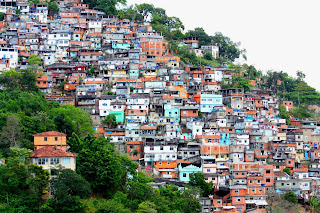 |
| Photo Credit: Flickr Dany13 |
Author: Sean Weaver, DO MPH and Nathan Cleveland, MD MS
University of Nevada School of Medicine
Originally Published: Common Sense, November/December 2015
Favela is a term from Brazilian Portuguese that refers to a heavily populated, urban, informal settlement. In other words, a shanty town. Born out of necessity, favelas look disorganized, haphazard, temporary, and chaotic. To its inhabitants, however, the favela represents a vibrant and constantly evolving community built on cooperative living. This vibrancy has led to some of Brazil’s most famous cultural contributions. Samba, capoeira, and funk all came from favelas.[1]
Free Open-Access Meducation (FOAM) is the favela of medical education. Early adopters of social media in emergency medicine and critical care began sharing information through Facebook, Twitter, podcasts, and blogs. As connections were made, experts began spontaneously discussing ideas and practice habits. These conversations were open to the public and anyone could participate. Over time, a structure began to develop and the number of participants increased.[2] In 2012, over a pint of Guinness, emergency physicians Sean Rothwell and Mike Cadogan named this informal online community “FOAM.”[3]
Early participants in FOAM recognized several key elements. They believed that knowledge was not proprietary. When your primary focus is medical education and good patient outcomes, the world becomes very flat. Social media created an environment where providers could figure it out together. Regardless of level of training, geographic location, health care system, or patient population emergency physicians can now share experiences, information and opinions in ways never before realized.
This energetic conversation reflects our dynamic profession, and the benefits are clear. As Joe Lex, the godfather of #FOAMed, once said:
If you want to know how we practiced medicine 5 years ago, read a textbook.
If you want to know how we practiced medicine 2 years ago, read a journal.
If you want to know how we practice medicine now, go to a (good) conference.
If you want to know how we will practice medicine in the future, listen in the hallways and use FOAM.
– Joe Lex, MD MAAEM FAAEM[4]
Successful emergency physicians are committed learners. It is commonly felt that a significant portion of our medical knowledge is obsolete in two to five years. Regardless of the rate of decay, the practice of emergency medicine demands lifelong learning. FOAM facilitates that learning. Using FOAM, you engage the global community of emergency medicine in real time. Instead of waiting for your favorite annual conference to confer with your peers, you have the opportunity to connect in the moment. When these interactions lead to deeper knowledge and better patient outcomes, everyone benefits.
Finally, FOAM potentially decreases the time between knowledge acquisition and clinical application. Traditional medical knowledge dissemination through print journals and textbooks can take one to two decades to get to the practicing medical community.[5] Blogs and podcasts like The Skeptics Guide to Emergency Medicine audaciously strive to cut that time to less than one year.[6] The creation of online journal clubs like ALiEM-Annals Global EM Journal Club Series or The Skeptic’s Guide to Emergency Medicine Hot Off the Press have contributed to achieving this goal. Participants have the unique opportunity to interact with the lead authors of practice-changing papers. Slowly but surely, the gaps between author, learner, and clinical application are narrowing.
Improving knowledge translation has real-world implications. One example is the article “Preoxygenation and Prevention of Desaturation During Emergency Airway Management,” published by Scott Weingart, MD and Rich Levitan, MD in Annals of Emergency Medicine.[7] They capitalized on FOAM resources to push the information to the emergency medicine community. According to Altmetric, a company that tracks social media metrics for Elsevier, this article is in the top 5% of all articles ever tracked by their company.[8] FOAM enhanced the impact of the article and influenced the standard of care.
Some may be quick to dismiss examples like that. They believe the FOAM movement lacks permanence. But, much like the favelas that cling to the hillsides surrounding Rio de Janeiro, looks can be deceiving. The most famous favelas are brick and mortar and built to last. They thrive, and the cultural contributions of such communities have been significant.[9]
The FOAM movement is following a similar trajectory. It holds great potential for students, residents, and practicing physicians alike. It cannot supplant a strong foundation of basic emergency medicine knowledge, but it does enrich that knowledge base and enhance the learning process. It promotes conversation, the sharing of experience, and the dissemination of knowledge. Participate in the FOAM community and you’ll be a stronger clinician.
|
FOAM Resources
|
Resident Driven Content
|
Twitter
|
|
@airwaycam
|
||
|
@srrezaie
|
||
|
@LWestafer
|
||
|
@UCIrvineEM
|
||
|
@TheSGEM
|
||
|
#FOAM
|
||
|
#FOAMed
|
Sean Weaver tweets at @_seanweaver and blogs at www.lasvegasemr.com/FOAM-Blog
Nathan Cleveland tweets @nathancleveland.
References
1. Barbosa J. Favela Culture Makes the City. 2012. http://www.rioonwatch.org/?p=4521. Accessed August 31, 2015.
2. Cadogan M, Thoma B, Chan TM, Lin M. Free Open Access Meducation (FOAM): the rise of emergency medicine and critical care blogs and podcasts (2002-2013). Emergency Medicine Journal. 2014;31(e1):e76-e77. doi:10.1136/emermed-2013-203502.
3. Nickson CP, Cadogan MD. Free Open Access Medical education (FOAM) for the emergency physician. Emergency Medicine Australasia. 2014;26(1):76-83. doi:10.1111/1742-6723.12191.
4. Lex J. International EM Education Efforts & E-Learning, 2012. Free Emergency Talks. 2015. http://freeemergencytalks.net/wp-content/uploads/2012/08/2012-08-21-08h00-International-EM-Education-Efforts-E-Learning.mp3. Accessed August 31, 2015.
5. Sussman S. Translation in the Health Professions: Converting Science into Action. Evaluation & the Health Professions. 2006;29(1):7-32. doi:10.1177/0163278705284441.
6. Milne K. What is the SGEM? The Skeptics Guide to Emergency Medicine. http://thesgem.com/what-is-the-sgem. Accessed August 31, 2015.
7. Weingart SD, Levitan RM. Preoxygenation and Prevention of Desaturation During Emergency Airway Management. Annals of Emergency Medicine. 2012;59(3):165-175.e1. doi:10.1016/j.annemergmed.2011.10.002.
8. BBC. Favela life: Rio’s city within a city. BBC Latin America & Caribbean. http://www.bbc.com/news/world-latin-america-27635554. Published June 9, 2014. Accessed August 31, 2015.
